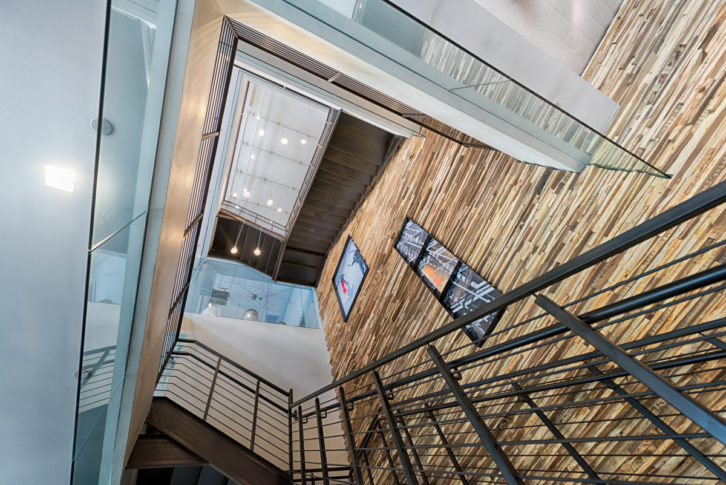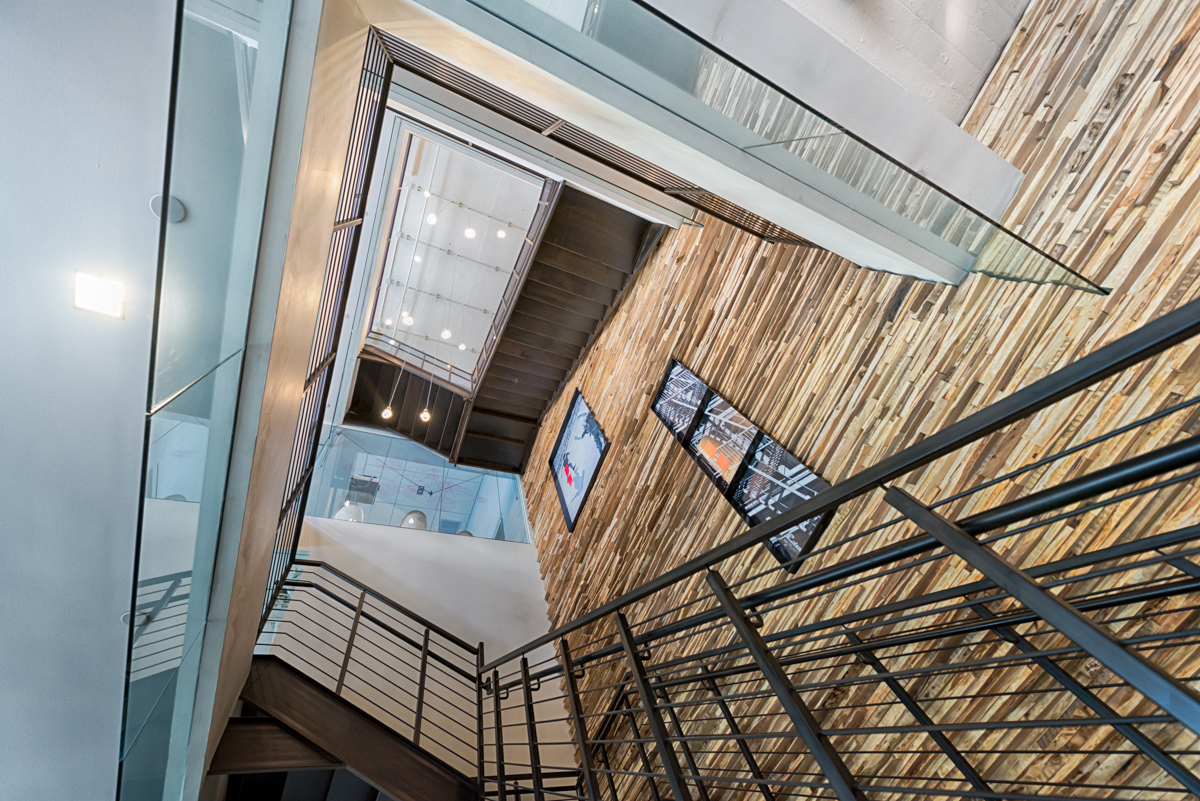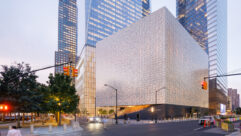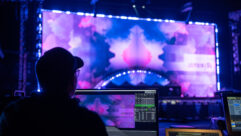

Invisible Network
Sep 15, 2014 8:39 AM, By Cynthia Wisehart
How a virtual AV matrix serves a global marketing firm
Inside Havas Worldwide in Manhattan, AV is everywhere, and nowhere. It’s visually integrated into the architecture; it runs on the main enterprise network; the sources move freely through the open, glass-filled building, across eight stories and 150 rooms. Nearly any source goes to nearly any display; there’s no AV rack room. You can pop your phone onto to a huddle display or pump full HD onto a 25ft. canvas. You can send your videoconference feed upstairs; you can monitor your focus group from just about anywhere.

The offices of Havas Worldwide in Manhattan span eight floors with a converged AV and IT network incorporating SVSi AV endpoints, Crestron QM-RMC control, Apple TV, and dedicated iPads. Systems design by TAD Associates; integration by Verrex.
The Havas Group is one of world’s largest global communication groups with a client roster of iconic brands.
When Havas Worldwide moved into a new soaring glass play structure in Hudson Square, the AV needed to be as fluid as the building. It needed to support a culture of serendipity and collaboration for more than 1,000 team members, with the image quality advertising professionals expect.
TPG’s architectural design for the nearly 300,000-square-foot high-rise bursts into light-filled corridors and caverns. The space is punctuated by flexible collaborative spaces of different sizes and moods, from cozy to spectacular; it encourages staff and clients to gather anywhere, informally or formally—and always with media available. Part of the design study involved making sure no one would be more than a few meters from a display they could use, no matter where they were in the building.
Now, how to back that with an AV system?
Jon Reeves, co-owner and principal designer at TAD Associates, says Havas creative officer Phil Silvestri was very clear about what he wanted, intelligent about what his colleagues would (and would not) really use, and discerning about where the ideal and the practical could converge.
“This system was driven by the workflow of the creative talent,” Reeves says. “Phil would say, ‘I want to go into a room and broadcast to 20 other rooms. I want to edit right in the client presentation.’ He wanted the content to be accessible on various scales and throughout the building. He’d blue-sky and then we’d go back to the drawing board with our lead designer James Utterback to think about products that could satisfy those requirements.

While much of the AV is designed to feel effortless and inconspicuous, an exception is the spectacular Main Presentation Room, the project’s most intense design deliverable—headed by TAD’s Guy Lafontant and integrated by Verrex. Floor-mounted short-throw projectors serve a unique design of moveable panels that can scale across the 25ft. span or physically slide aside to reveal the Hudson Square skyline. This creates a versatile canvas for everything from animated graphics to client presentations to impromptu screenings of the World Cup. The room lends itself to flexible seatingconfigurations; wireless speakers give mobility to presenters, and voice and program audio can be broadcast throughout the main hall.
“The way we like to work,” Reeves continues, “is to become part of the workforce, live through the requirements and objections, and start articulating the system in terms of a day-in-the-life at Havas.”
Some of TAD’s design communication aids included floor plan studies and three-dimensional models showing connectivity of workflow from greater groups to smaller groups. TAD put on a series of product demonstrations, did a lot of benchmarking and testing, even building a room onsite—“a kind of lab where they could kick the tires.” In the process, they also built a dialogue with Havas IT director John Morea and his department—a relationship that would be vital to the success of the project.
One of the key product decisions was to go with the SVSi V-Series of JPEG2000 encoders/decoders. “The beauty of the SVSi product is it is just a box and a wire,” Reeves says. This allowed the network to be decentralized— point-to-point in all directions—creating a flexible virtual AV matrix that wasn’t bounded by hardware and is “headend-less.”
SVSi’s Bob Sharp calls the Havas installation a converged network. Meaning that the AV network is not separate from the client’s IT network, rides over the same infrastructure, and is connected in by enterprise Cisco switchers—just like any other piece of network gear. There is a VLAN (virtual local area network) for the AV system (and another one for the VoIP phones). It’s one network, and Morea and his team administer it all.
“A $500 Cisco switch is among the most reliable and proven pieces of technology in the world,” Sharp says. “We’re able to make AV speak that language and put a large amount of high-quality AV on the main network. There is this sort of mantra that you can never put that on the company network, but this is a classic example of when IT and AV work cooperatively and the technology is truly compatible. It dispels the myth that professional AV on the corporate network is never going to work.”
Invisible Network
Sep 15, 2014 8:39 AM, By Cynthia Wisehart
How a virtual AV matrix serves a global marketing firm
The SVSi V-Series endpoints are the AV signal distribution backbone and ensure that the signal retains its quality through encryption, compression, and transport. “It’s a creative agency,” Reeves says. “That kind of high-rez, high-bandwidth, low-latency, color-saturated quality is really important.” However, the other key to the Havas AV system was pairing a small Crestron QM-RMC processor? with the SVSi boxes. For this application, Crestron is “the brain at the end-point,” Reeves says. “The control system is what makes it a success for the user interface, and it’s what allowed the IT group to manage all the rooms,” including taking charge of the dedicated iPads that serve as the GUI in each of the rooms for the SVSi encoders/decoders and Apple TVs.
“One of the big delineations for Havas is they were not 100 percent mobile; there were still PCs in play,” Reeves explains. “They want to log on, remote to their desktop, and collaborate within the room. It’s just got to work. That’s where I believe a control environment— an AMX or Crestron—fits into this type of network. It’s like a light switch, and some rooms really work well that way.
“It’s all down to the client,” Reeves sums up. “And in the future, who knows? We may move more to onscreen commands as opposed to a control environment or a hybrid.”
Sharp says the company remains agnostic on control and mindful of the decades of investment, expertise, and skill associated with established control systems. In the time since the Havas project was specified, SVSi has also moved to expand the native control capabilities of its own products and the usefulness of its API. Designers and integrators may choose to use that control in more standalone ways or use the API to develop custom software and/or integrate with third-party control.
Indeed the Havas project was a very modern example of IT and AV expertise working together toward a common end. Reeves says the systems integrator, Verrex, played a key role in facilitating the SVSi/Crestron integration, as well as optimizing many of the pieces of the network and displays.

“One way to think about it is we were enabling content ingest, broadcast, and collaboration”— for a range of locations audiences, resolutions, and sources, over an IT network. “The ‘aha’ moment was when we were able to broadcast full motion video like it was WebEx,” Reeves says. “But it was a learning curve to connect the client’s IT group and SVSi and go onsite and manage that process. It took a team effort between us, the integrator, and the client. And also having manufacturers like SVSi and Crestron who will really back up and stand behind their products and interface with the network.”
Verrex engineering director Ben Dandola-Grubb recalls getting the first drawings, marking them up and heading into TAD’s Manhattan offices to meet face to face. “We sat there for three hours and went over every one of my questions,” he recalls.
“I really liked the idea of doing an AV matrix without the hardware matrix, and putting the client network at the heart of the system. I’m excited about where that has the potential to go in the future.”
Both Dandola-Grubb and Verrex account executive Scott Farrara emphasize that this kind of virtual matrix system needs a well-managed corporate network, good interoperability among network elements, and a strong client IT team to succeed.
“It’s going well,” Morea confirms. As Havas IT director, he had had the pleasure of managing the network under full load, once everybody was on it, and doing the necessary tweaking. “And training,” he emphasizes. “At first it was painful because the users didn’t know. They were pulling wires and pushing buttons; training has cleared a lot of that out. People are really using the equipment, which is what you really hope will happen. We do weekly training for all the users coming in to make sure they’re familiar with the aspects of the room, what not to do, and who to call.”
Invisible Network
Sep 15, 2014 8:39 AM, By Cynthia Wisehart
How a virtual AV matrix serves a global marketing firm

“The network is in all our jobs today,” Reeves concludes. “We see it in our projects; our recent hires are network engineers. We’re tying into a massive IT structure, and AV has to flow from that. It’s not designing screens on walls anymore. If I fail at the IT objectives, I’ve failed the client.”
The Havas AV system has two personalities. In many of the rooms, the AV is understated and out of sight, except for the big lux displays. Farrara describes the Polycom videoconferencing suites on each floor as elegant with no extra equipment. Other rooms, he says, feel like living rooms or friendly conference rooms. “They might start out with a standard conference room with a table, then they might put in couches, then chairs for a classroom, then tables for dinner.”
Havas is, after all, an advertising agency, so there is also a full-blown inhouse production studio that feeds glamorous, saturated HD and graphics to the inhouse screening theater and the 25ft. panorama in the client presentation room. The screening theater has a full edit bay right in the room. There are glass focus-group “cubes,” visible as work-in-progress from throughout the building, as well as available by IP camera feed.
The network serves all personalities— robust and discreet, powerful and effortless, flashy, and invisible.
What is a virtual matrix?
It provides conventional matrix switching of AV sources to AV endpoints (displays) without the need for a physical fixed-size (32×32, etc.) switch frame. Additionally, it is a decentralized matrix, i.e. sources and endpoints can exist anywhere on the network.










